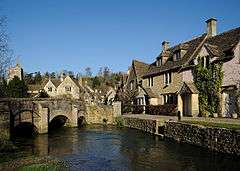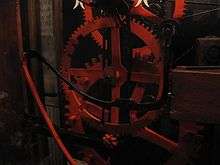Castle Combe
| Castle Combe | |
 The main street and Bybrook River |
|
 Castle Combe |
|
| Population | 344 (in 2011)[1] |
|---|---|
| OS grid reference | ST842771 |
| Unitary authority | Wiltshire |
| Ceremonial county | Wiltshire |
| Region | South West |
| Country | England |
| Sovereign state | United Kingdom |
| Post town | Chippenham |
| Postcode district | SN14 |
| Dialling code | 01249 |
| Police | Wiltshire |
| Fire | Dorset and Wiltshire |
| Ambulance | South Western |
| EU Parliament | South West England |
| UK Parliament | North Wiltshire |
| Website | Village |
Coordinates: 51°29′35″N 2°13′44″W / 51.493°N 2.229°W
Castle Combe is a village and civil parish in Wiltshire, England, about 5 miles (8 km) northwest of the town of Chippenham.
The village has two parts: one is in the narrow valley of the By Brook, while Upper Castle Combe is on higher ground to the east, on the B4039 road which links Chippenham with Chipping Sodbury. A motor racing circuit is to the south of the upper village.
History
The village takes its name from the 12th-century castle which stood 600 metres to the north.
The 14th-century market cross, erected when the privilege to hold a weekly market in Castle Combe was granted, stands where the three principal streets of the lower village converge.[2] Next to the cross is one of Castle Combe's two village pumps.[3] Small stone steps near the cross were for horse riders to mount and dismount, and close by are the remains of the buttercross, built in the late 19th century from old masonry.[4]
The village prospered during the 15th century when it belonged to Millicent, the wife of Sir Stephen Le Scrope and then of Sir John Fastolf (1380–1459), a Norfolk knight who was the effective lord of the manor for fifty years. He promoted the woollen industry, supplying his own troops and others for Henry V's war in France.
Notable houses include the Dower House, from the late 17th century and now Grade II* listed.[5]
A National School was built in 1826, on a site between the upper and lower villages. The school was taken over by the county council in 1909, and educated children of all ages until 1956 when older pupils were transferred to secondary schools in Chippenham. It closed in 1998 on the opening of a new primary school at Yatton Keynell.[6]
Religious sites
Parish church
The Church of England parish church of St Andrew is a Grade I listed building.[7] Part of the chancel is 13th-century while most of the rest of the building is from the 15th, reflecting the prosperity of the local wool and cloth industry. The tower was begun in 1434 and completed in 1576. In 1850–51 nearly all of the building, except the tower, was taken down and reconstructed to almost the same plan.[8]
Inside the church is a chancel arch with fine carving, and a 14th-century stone font. The Lady Chapel has an effigy of Sir Walter de Dunstanville (d. 1270) and later monuments to the Scrope family. The faceless church clock, probably late 15th-century, is among the oldest working clocks in the country.
The church is part of the Bybrook Team Ministry.[9]
Congregational Church
The first chapel was built in 1757 and extended with a schoolroom in 1846.[10] The current church, opened in 1914, is in the upper part of the village on what is now the B4039 road. The building is a former malt house and is attached to an 18th-century house which became the manse.[11]
The church continues in use.[12]
Today
A motor racing venue, Castle Combe Circuit, is located on the site of the former RAF Castle Combe airfield near the village.
The village has twice played host to the Combe Sunday event, a music extravaganza which attracted 4,000 visitors to the village in 2006.
Castle Combe is represented in parliament by James Gray, and in Wiltshire Council by Jane Scott, both Conservatives.
In popular culture
The village was a location for the 1967 film musical Doctor Dolittle, but its frequently rainy summer climate, and the residents' irritation at the producers' arbitrary modifications of the area for shooting that was severe enough to incite attempted sabotage, frustrated production.[13] Raymond Austin, director/writer, set the action of his book, Find me a Spy, Catch me a Traitor in the village and at the Manor. Other productions include "The Murder of Roger Ackroyd", an episode of Agatha Christie's Poirot, and the films Stardust and The Wolfman. Throughout September 2010, the village was used as a key filming location for Steven Spielberg's production of War Horse. The house of Alice Cartalet in the manga and anime series Kiniro Mosaic was based on Fosse Farmhouse, a guesthouse near Castle Combe.[14]
In the spring of 2012, it was a filming location for the fantasy adventure movie Mariah Mundi and the Midas Box. Most recently it was used for the upcoming series of Downton Abbey.
There had been plans to film outdoors scenes from Wings of the Eagle in Castle Combe and nearby Lacock in 2015, but these plans were scrapped by BBC producers due to lack of public funding.
Tourist services
Castle Combe has a car park at the top of the hill, and toilet facilities over the bridge at the bottom of the village. There was a small museum but it closed in 2012.[15]
The 5-star Manor House Hotel is in the west end of the village. The house was built in the 17th century and rebuilt in the 19th.[16] It has 48 rooms and 365 acres (1.5 km2) of gardens. During World War II, the New Zealand Forestry Officers had the Manor House as their headquarters. In 1947, the owner of the Castle Combe estate sold the houses of the estate and the Manor House became a country club. After 18 months the club left the premises, and the house was shortly thereafter sold to Bobbie Allen, an amateur hotelier, and her husband. Over time, they established the Manor House as a premier country hotel, run almost as a club. A quite glamorous clientele ensued. Certain of the London hotels would refer guests in search of authentic England to the Manor House. Mrs. Allen was a noted horsewoman, and the grounds of the Manor House were known for their suitability for riding. Mrs. Allen was from Lancashire, and quite direct. She wrote a charming book of her experiences, From Claridge's to Castle Combe, which reflects this directness.[17] After many years, the Allens sold the Manor House to Mr. and Mrs. Oliver Clegg, who sold it to the present owners.
Gallery
 14th-century market cross
14th-century market cross Looking up Water Street
Looking up Water Street Manor House Hotel
Manor House Hotel Old Rectory Tea Room
Old Rectory Tea Room St Andrew's Church
St Andrew's Church Castle Combe Clock in the church
Castle Combe Clock in the church
References
- ↑ "Wiltshire Community History – Census". Wiltshire Council. Retrieved 24 September 2014.
- ↑ Historic England. "Medieval market cross immediately east of St Andrew's Church (1019387)". National Heritage List for England. Retrieved 21 March 2016.
- ↑ http://www.villagepumps.org.uk/pumpsWilts.htm
- ↑ Historic England. "The Butter Cross (1283541)". National Heritage List for England. Retrieved 21 March 2016.
- ↑ Historic England. "The Dower House (1199036)". National Heritage List for England. Retrieved 21 March 2016.
- ↑ "Castle Combe School". Wiltshire Community History. Wiltshire Council. Retrieved 21 March 2016.
- ↑ Historic England. "Church of St Andrew (1022864)". National Heritage List for England. Retrieved 20 March 2016.
- ↑ "Church of St. Andrew, Castle Combe". Wiltshire Community History. Wiltshire Council. Retrieved 20 March 2016.
- ↑ "St Andrew, Castle Combe". Bybrook Team Ministry. Retrieved 20 March 2016.
- ↑ "Congregational Chapel, Castle Combe". Wiltshire Community History. Wiltshire Council. Retrieved 20 March 2016.
- ↑ Historic England. "The Manse and Congregational Chapel (1199215)". National Heritage List for England. Retrieved 20 March 2016.
- ↑ "Castle Combe Congregational Church". Retrieved 20 March 2016.
- ↑ Harris, Mark. Pictures at A Revolution. Penguin Press, 2008, p. 199-202
- ↑ "On location at Fosse Farm – Alice Cartalet's house from Kinmoza". Otaku News. Retrieved 7 April 2015.
- ↑ Winter, Alex (1 March 2012). "Castle Combe's mini museum shuts". Gazette & Herald. Retrieved 21 March 2016.
- ↑ Historic England. "The Manor House Hotel (1199055)". National Heritage List for England. Retrieved 21 March 2016.
- ↑ Allen, Bobbie (1968). From Claridge's to Castle Combe. Bath: The Mendip Press.
External links
| Wikimedia Commons has media related to Castle Combe. |
- Castle Combe at VisitWiltshire
- Castle Combe village website
- Bed and Breakfast accommodation
- Castle Combe history